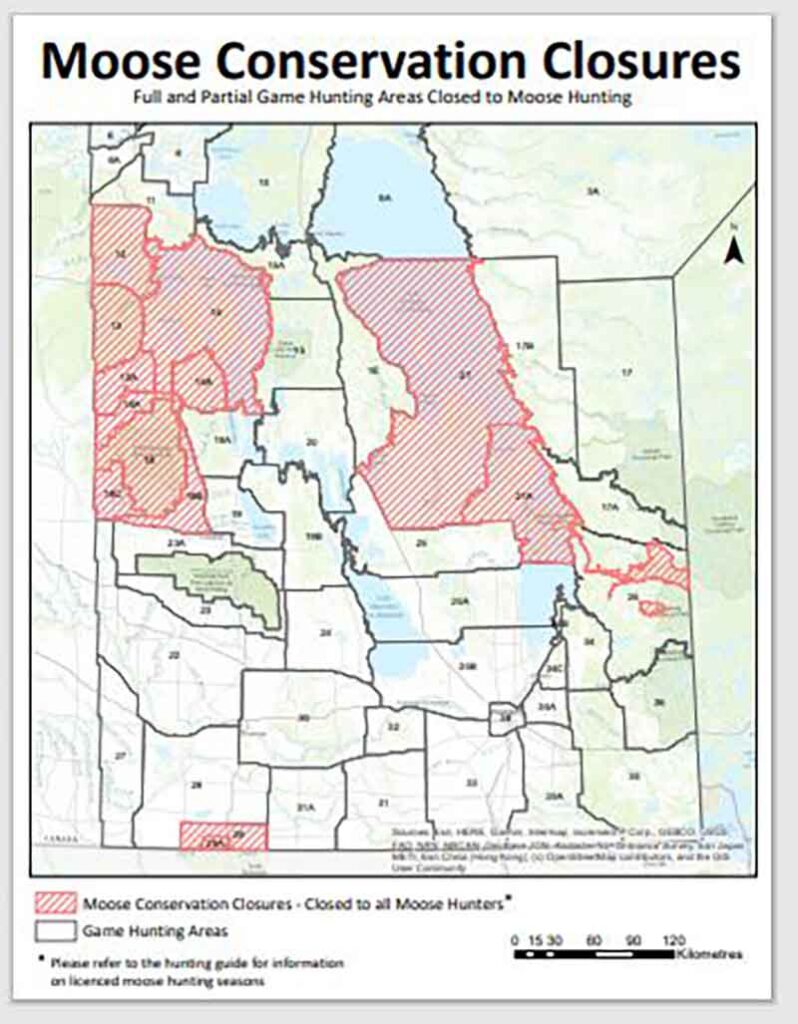The provincial government’s Wildlife Branch has been conducting aerial surveys over the course of February and March to determine moose population trends across the province, including in the Interlake where hunting in some areas is prohibited.
The branch’s population assessment manager Kirsten Solmundson, who was hired by the province last May, said that in general moose populations are declining in many parts of the province.
“Aerial surveys conducted in 2010 and 2011 revealed declining trends in several Game Hunting Areas, which prompted conservation closures to restrict moose hunting in those areas,” said Solmundson.
Closed areas include the Duck Mountain Game Hunting Area [GHA), numbered 18, 18A, 18B and 18C, and the Porcupine Mountain GHA, numbered 13 and 13A, according the branch’s webpage and moose hunting closure map. Moose hunting is also close in the Hecla-Grindstone region and regions in the Municipality of Bifrost-Riverton, as well as along the east shore of Lake Winnipeg and up past Berens River. The west side of Lake Winnipeg, along Fisher Bay, west to Lake St Martin, as well as northwards almost to Grand Rapids is also closed to moose hunting.
Solmundson said moose populations face a variety of environmental and human-related threats that can affect their numbers.
“Moose are facing a number of threats, including parasites and disease such as winter tick and brainworm [a parasitic roundworm causing weakness, lack of coordination, circling behaviour deafness and other symptoms], climate change, over-hunting, loss of suitable habitat due to development and fire suppression, and other landscape changes,” said Solmundson. “As an example, human development can increase the success of predators (wolves and black bears) by creating sightlines through the forest (i.e., linear features such as roads or ATV trails). Human development and climate change have also resulted in increasing white-tailed deer populations in areas that were historically primarily moose habitat, which can increase overall predator abundance and put additional pressures on moose.”
The province is currently conducting aerial surveys (by plane or drone) using infrared and RGB (red, green and blue wavelengths) imaging technology, which is an effective way to detect mammals in a variety of habitats. The technology doesn’t rely on snow cover, which increases the department’s capacity to undertake surveys, said Solmundson. The method also provides georeferenced video data for all the observations, which increases the reliability and transparency of the surveys.
Over the course of February and March, the province is surveying moose in five Game Hunting Areas: 17A, 21, 21A, 26, and 27. Researchers are also collecting data on other big game species such as elk and caribou if present.
Specialist aerial researchers are using aerial infrared technology on a fixed-wing plane for the two Interlake areas (21 and 21A). The plane is equipped with a military-grade infrared sensor, an RGB camera with an optical zoom, laser distance meter and an on-board augmented reality system, said Solmundson. The technology enables the surveyors to quickly and accurately detect and count large mammals such as moose, elk, caribou and deer.
For moose in particular, infrared technology can detect them in heavily forested areas where they could be difficult to spot.
“The infrared sensor is so powerful that it can detect the heat difference of the pedicles on a bull moose after the antlers have been shed, allowing us to collect accurate sex ID data throughout the winter. Obtaining high quality data allows the Wildlife Branch to produce accurate results when calculating population sizes and sex ratios,” said Solmundson. “The infrared technology is an effective method to detect any large mammal and the surveys can also provide insights on other species such as wolves, lynx and invasive pigs without the need to invest in additional survey efforts.”
The survey’s results will be able to tell the department what the general trends are across Manitoba and to determine how many moose can be hunted.
“The Wildlife Branch considers the estimated abundance, sex ratios, calf ratios and long-term trends of wildlife populations as a metric of population health and to determine sustainable harvest rates,” said Solmundson.
Typically, the province carries out aerial moose surveys in three to five GHAs each winter, although past surveys have had to be cancelled because of insufficient snow cover, she said. Updated technology, however, allow surveys to be conducted regardless of snow cover.
Solmundson previously studied caribou populations on islands in Lake Superior for her PhD thesis. She used DNA sequencing to compare the isolated herds to caribou in Manitoba, Ontario and Quebec. The herds found on the islands were a “unique genetic group.”
“My findings indicate that these genetic differences are caused by multiple factors including local adaptation, inbreeding and other island dynamics. My research was conducted collaboratively with biologists from the Ontario Ministry of Natural Resources and Environment and Climate Change Canada,” she said. “The findings from my research are being used to guide future conservation and management decisions for caribou in the Lake Superior Range.”
For more information on threats to Manitoba’s moose population, visit: www.gov.mb.ca/nrnd/fish-wildlife/pubs/fish_wildlife/hard-to-be-a-moose.pdf
Annual big game survey reports and a survey method FAQ guide are also posted on the Wildlife Branch’s website.

